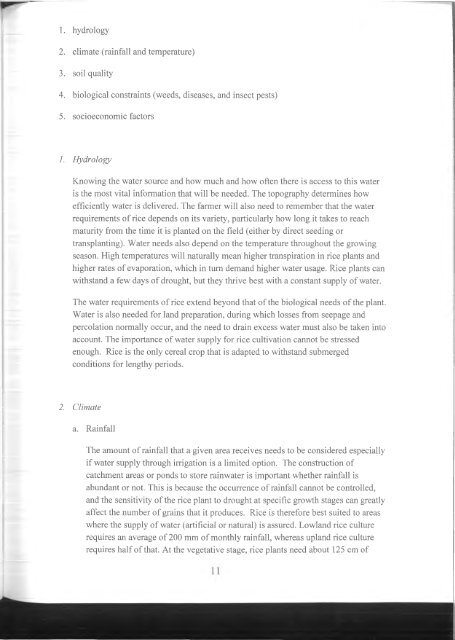Bradbrook - 2012 - Rice Farming complete with methods to increase ric
Bradbrook - 2012 - Rice Farming complete with methods to increase ric
Bradbrook - 2012 - Rice Farming complete with methods to increase ric
You also want an ePaper? Increase the reach of your titles
YUMPU automatically turns print PDFs into web optimized ePapers that Google loves.
г 1.<br />
hydrology<br />
2. climate (rainfall and temperature)<br />
3. soil quality<br />
4. biological constraints (weeds, diseases, and insect pests)<br />
5. socioeconomic fac<strong>to</strong>rs<br />
1. Hydrology<br />
Knowing the water source and how much and how often there is access <strong>to</strong> this water<br />
is the most vital information that will be needed. The <strong>to</strong>pography determines how<br />
efficiently water is delivered. The farmer will also need <strong>to</strong> remember that the water<br />
requirements of <strong>ric</strong>e depends on its variety, particularly how long it takes <strong>to</strong> reach<br />
maturity from the time it is planted on the field (either by direct seeding or<br />
transplanting). Water needs also depend on the temperature throughout the growing<br />
season. High temperatures will naturally mean higher transpiration in <strong>ric</strong>e plants and<br />
higher rates of evaporation, which in turn demand higher water usage. <strong>Rice</strong> plants can<br />
<strong>with</strong>stand a few days of drought, but they thrive best <strong>with</strong> a constant supply of water.<br />
The water requirements of <strong>ric</strong>e extend beyond that of the biological needs of the plant.<br />
Water is also needed for land preparation, during which losses from seepage and<br />
percolation normally occur, and the need <strong>to</strong> drain excess water must also be taken in<strong>to</strong><br />
account. The importance of water supply for <strong>ric</strong>e cultivation cannot be stressed<br />
enough. <strong>Rice</strong> is the only cereal crop that is adapted <strong>to</strong> <strong>with</strong>stand submerged<br />
conditions for lengthy periods.<br />
2. Climate<br />
a. Rainfall<br />
The amount of rainfall that a given area receives needs <strong>to</strong> be considered especially<br />
if water supply through irrigation is a limited option. The construction of<br />
catchment areas or ponds <strong>to</strong> s<strong>to</strong>re rainwater is important whether rainfall is<br />
abundant or not. This is because the occurrence of rainfall eannot be controlled,<br />
and the sensitivity of the <strong>ric</strong>e plant <strong>to</strong> drought at specific growth stages can greatly<br />
affect the number of grains that it produces. <strong>Rice</strong> is therefore best suited <strong>to</strong> areas<br />
where the supply of water (artificial or natural) is assured. Lowland <strong>ric</strong>e culture<br />
requires an average of 200 mm of monthly rainfall, whereas upland <strong>ric</strong>e culture<br />
requires half of that. At the vegetative stage, <strong>ric</strong>e plants need about 125 cm of

















